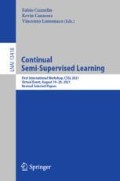Abstract
Novelty detection aims to automatically identify out of distribution (OOD) data, without any prior knowledge of them. It is a critical step in continual learning, in order to sense the arrival of new data and initialize the learning process. Conventional methods of OOD detection perform multi-variate analysis on an ensemble of data or features, and usually resort to the supervision with OOD data to improve the accuracy. In reality, such supervision is impractical as one cannot anticipate the anomalous data. In this paper, we propose a novel, self-supervised approach that does not rely on any pre-defined OOD data: (1) The new method evaluates the Mahalanobis distance of the gradients between the in-distribution and OOD data. (2) It is assisted by a self-supervised binary classifier to guide the label selection to generate the gradients, and maximize the Mahalanobis distance. In the evaluation with multiple datasets, such as CIFAR-10, CIFAR-100, SVHN and ImageNet, the proposed approach consistently outperforms state-of-the-art supervised and unsupervised methods in the area under the receiver operating characteristic (AUROC). We further demonstrate that this detector is able to accurately learn one OOD class in continual learning.
Access this chapter
Tax calculation will be finalised at checkout
Purchases are for personal use only
References
Abati, D., Porrello, A., Calderara, S., Cucchiara, R.: Latent space autoregression for novelty detection. In: Proceedings of the IEEE/CVF Conference on Computer Vision and Pattern Recognition, pp. 481–490 (2019)
Chen, J., Sathe, S., Aggarwal, C., Turaga, D.: Outlier detection with autoencoder ensembles. In: Proceedings of the 2017 SIAM International Conference on Data Mining, pp. 90–98. SIAM (2017)
Du, X., Li, Z., Seo, J.s., Liu, F., Cao, Y.: Noise-based selection of robust inherited model for accurate continual learning. In: Proceedings of the IEEE/CVF Conference on Computer Vision and Pattern Recognition Workshops, pp. 244–245 (2020)
Goodfellow, I.J., et al.: Generative adversarial networks. arXiv preprint arXiv:1406.2661 (2014)
Hawkins, S., He, H., Williams, G., Baxter, R.: Outlier detection using replicator neural networks. In: Kambayashi, Y., Winiwarter, W., Arikawa, M. (eds.) DaWaK 2002. LNCS, vol. 2454, pp. 170–180. Springer, Heidelberg (2002). https://doi.org/10.1007/3-540-46145-0_17
He, K., Zhang, X., Ren, S., Sun, J.: Deep residual learning for image recognition. In: Proceedings of the IEEE Conference on Computer Vision and Pattern Recognition, pp. 770–778 (2016)
Hendrycks, D., Gimpel, K.: A baseline for detecting misclassified and out-of-distribution examples in neural networks. arXiv preprint arXiv:1610.02136 (2016)
Kingma, D.P., Ba, J.: Adam: A method for stochastic optimization. arXiv preprint arXiv:1412.6980 (2014)
Krizhevsky, A., et al.: Learning multiple layers of features from tiny images (2009)
Kwon, G., Prabhushankar, M., Temel, D., AlRegib, G.: Novelty detection through model-based characterization of neural networks. In: 2020 IEEE International Conference on Image Processing (ICIP), pp. 3179–3183. IEEE (2020)
Lee, J., AlRegib, G.: Gradients as a measure of uncertainty in neural networks. In: 2020 IEEE International Conference on Image Processing (ICIP), pp. 2416–2420. IEEE (2020)
Lee, K., Lee, K., Lee, H., Shin, J.: A simple unified framework for detecting out-of-distribution samples and adversarial attacks. arXiv preprint arXiv:1807.03888 (2018)
Liang, S., Li, Y., Srikant, R.: Enhancing the reliability of out-of-distribution image detection in neural networks. arXiv preprint arXiv:1706.02690 (2017)
Mahalanobis, P.C.: On the generalized distance in statistics. Proc. Natl. Inst. Sci. 2, 49–55 (1936)
Netzer, Y., Wang, T., Coates, A., Bissacco, A., Wu, B., Ng, A.Y.: Reading digits in natural images with unsupervised feature learning (2011)
Paszke, A., et al.: Automatic differentiation in pytorch (2017)
Roth, P.M., Hirzer, M., Köstinger, M., Beleznai, C., Bischof, H.: Mahalanobis distance learning for person re-identification. In: Gong, S., Cristani, M., Yan, S., Loy, C.C. (eds.) Person Re-Identification. ACVPR, pp. 247–267. Springer, London (2014). https://doi.org/10.1007/978-1-4471-6296-4_12
Russakovsky, O., et al.: ImageNet large scale visual recognition challenge. Int. J. Comput. Vision 115(3), 211–252 (2015). https://doi.org/10.1007/s11263-015-0816-y
Sakurada, M., Yairi, T.: Anomaly detection using autoencoders with nonlinear dimensionality reduction. In: Proceedings of the MLSDA 2014 2nd Workshop on Machine Learning for Sensory Data Analysis, pp. 4–11 (2014)
Sehwag, V., Chiang, M., Mittal, P.: SSD: a unified framework for self-supervised outlier detection. arXiv preprint arXiv:2103.12051 (2021)
Shen, C., Kim, J., Wang, L.: Scalable large-margin mahalanobis distance metric learning. IEEE Trans. Neural Netw. 21(9), 1524–1530 (2010)
Xiang, S., Nie, F., Zhang, C.: Learning a mahalanobis distance metric for data clustering and classification. Pattern Recogn. 41(12), 3600–3612 (2008)
Yu, F., Seff, A., Zhang, Y., Song, S., Funkhouser, T., Xiao, J.: LSUN: construction of a large-scale image dataset using deep learning with humans in the loop (2016)
Zhou, C., Paffenroth, R.C.: Anomaly detection with robust deep autoencoders. In: Proceedings of the 23rd ACM SIGKDD International Conference on Knowledge Discovery and Data Mining, pp. 665–674 (2017)
Acknowledgements
This research was supported in part by the U.S. Department of Energy, through the Office of Advanced Scientific Computing Research’s “Data-Driven Decision Control for Complex Systems (DnC2S)” project. It was also partially supported by C-BRIC, one of six centers in JUMP, a Semiconductor Research Corporation (SRC) program sponsored by DARPA. Pacific Northwest National Laboratory is operated by Battelle Memorial Institute for the U.S. Department of Energy under Contract No. DE-AC05-76RL01830. Oak Ridge National Laboratory is operated by UT-Battelle LLC for the U.S. Department of Energy under contract number DE-AC05-00OR22725.
Author information
Authors and Affiliations
Corresponding author
Editor information
Editors and Affiliations
Rights and permissions
Copyright information
© 2022 The Author(s), under exclusive license to Springer Nature Switzerland AG
About this paper
Cite this paper
Sun, J. et al. (2022). Self-supervised Novelty Detection for Continual Learning: A Gradient-Based Approach Boosted by Binary Classification. In: Cuzzolin, F., Cannons, K., Lomonaco, V. (eds) Continual Semi-Supervised Learning. CSSL 2021. Lecture Notes in Computer Science(), vol 13418. Springer, Cham. https://doi.org/10.1007/978-3-031-17587-9_9
Download citation
DOI: https://doi.org/10.1007/978-3-031-17587-9_9
Published:
Publisher Name: Springer, Cham
Print ISBN: 978-3-031-17586-2
Online ISBN: 978-3-031-17587-9
eBook Packages: Computer ScienceComputer Science (R0)

